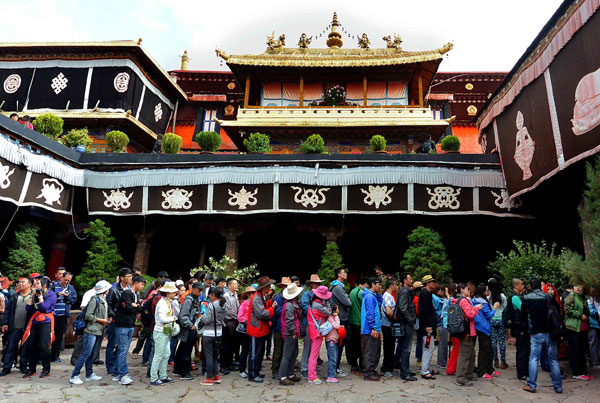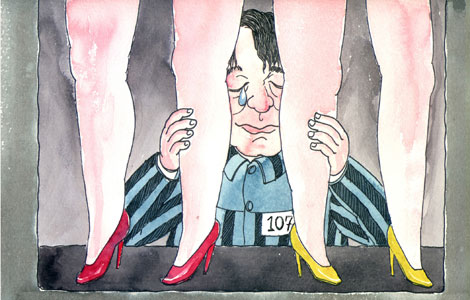Giving ancient Lhasa a facelift
Updated: 2013-07-23 08:52
By Wang Huazhong and Da Qiong (China Daily)
|
|||||||||||
Infrastructure update
Nyima Tsering, 79, was born and raised on Barkhor Street and remembers clearly how the place looked when he was a child.
He said the wind blew dust into the stalls along the narrow earth road during the hot summer. At the time, Nyima Tsering's house was the property of Tashilhunpo Monastery and beggars gathered around it.
Previous renovations freed his six-member family from drinking water from a well, using a non-flush toilet and having to light candles for illumination, yet he said their lives had remained "not so convenient" until recently.
The courtyard in which he lives is home to several families, about 26 people in all, including seniors aged 80 and older. They all shared one water tap on the ground floor before the latest renovation was completed at the end of June.
Before that, water couldn't even be pumped up to the second floor.
Because the pipes were just 20 cms in diameter, the drainage system failed to discharge sewage from many households. Foul water gushed out onto the street on rainy days, Nyima Tsering said.
 |
|
Tourists wait to enter Jokhang Temple in downtown Lhasa. The high season for visitors started in late June, and the city receives an average of 4,000 tourists every day. Wang Song / Xinhua |
In all, 199 courtyards are scattered along 35 alleys in the Barkhor Street area.
Tashi Dorje, a deputy in Lhasa's city congress, said that in the old house-intensive district, sewage and the fires used for cooking and heating threatened the safety of the crowded courtyards.
The renovation project has helped change the situation, the project leaders said.
Now all the overhanging cables have been buried underground in 31 km of piping tubes and tunnels.
More than 17,000 households now have their own electricity meters, which means they no longer share the bill with other courtyard residents.
To date, 1.2 km of new water pipes have been laid and 7 km of existing pipelines have been renovated. About 650 truckloads of mud were cleared from the drainage intakes.
Forty-six fire hydrants were installed and 2,200 km of decayed or illegally connected cables have been removed.
Yet what satisfies Nyima Tsering most is that the road he travels every day to pray has been widened and flattened.
The surface of the new roadway on Barkhor Street uses anti-slip bluestones that absorb, rather than reflect, strong sunlight and a lane in the middle of the road has been paved with smooth stones for the worshippers who prostrate themselves along its length.
More than 1,000 new street and wall lamps, all bearing Tibetan designs, have also been installed.
The old lamp bulbs were shaped like flowers, but the new designs look like prayer wheels and incorporate many Tibetan elements, such as the greeting tashi delek, which means "good fortune".
"The street was very busy and noisy. But now, I don't have to turn up the TV volume much because of the new windows," said Tsering lhamo.
The windows of her living room along Barkhor Street are double-glazed, insulating the house from noise and cold. A yellow wooden lattice painted with auspicious Tibetan signs hangs outside the window.
"I'm pleased to see that the old district has changed for good," Nyima Tsering said. "My children will live a better life and the old district will become more beautiful."
When the project was completed, the government of Chengguan district, where the renovation took place, conducted a survey to solicit public feedback on the quality of the work.
All the respondents from the 12 local communities said they were "satisfied" or "very satisfied" with the results.
The old district is the original soul of Lhasa and a mirror that showcases the city's charm and history.
Related Stories
Lhasa completes renovation of old city 2013-07-01 07:52
Today's Top News
Quake in NW China kills 89, injures 700
Kate gives birth to a baby boy
New visas to boost family reunions
Huawei launches mobile app contest in EU
China to implement stricter air quality controls
China's FX purchases decline
Police get drug giant's help in bribery scandal
'Black Monday' as WeChat service lost
Hot Topics
Lunar probe , China growth forecasts, Emission rules get tougher, China seen through 'colored lens', International board,
Editor's Picks

|

|

|

|

|

|






